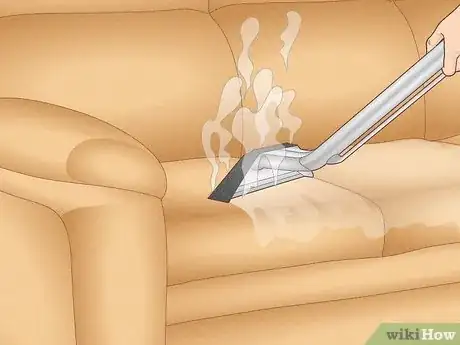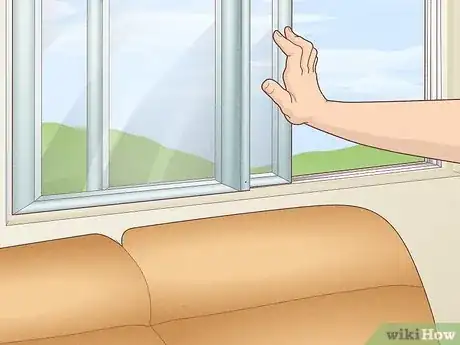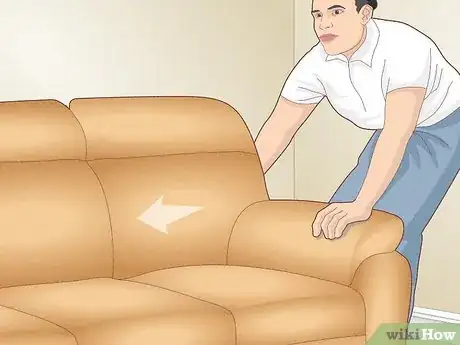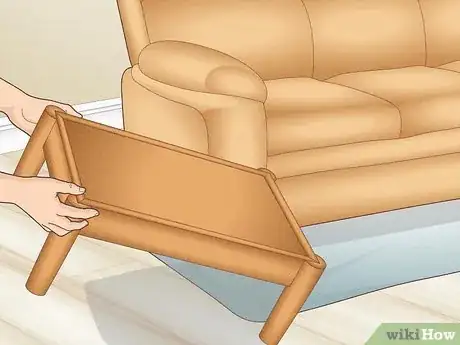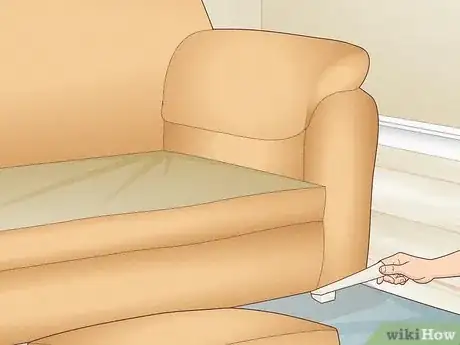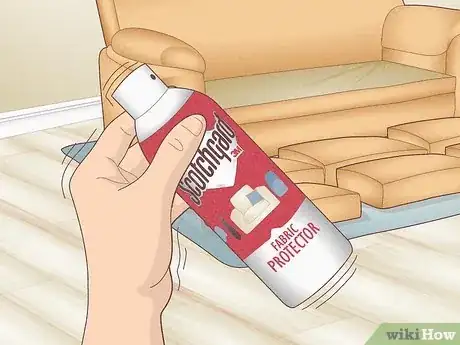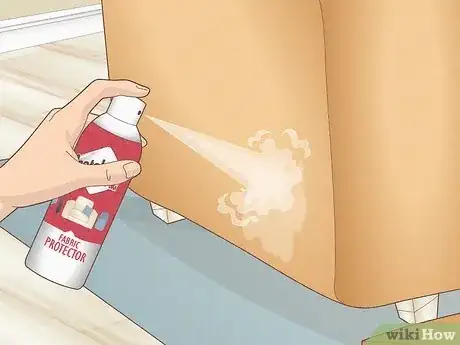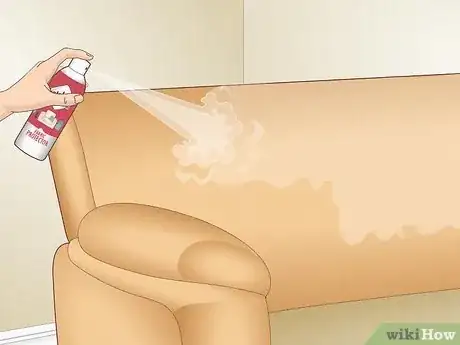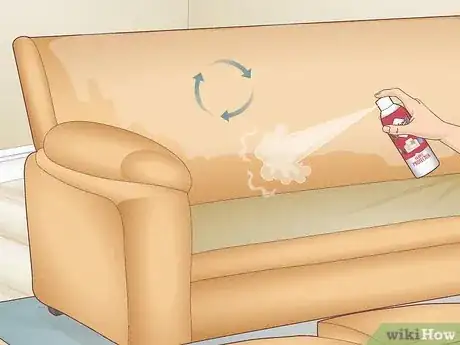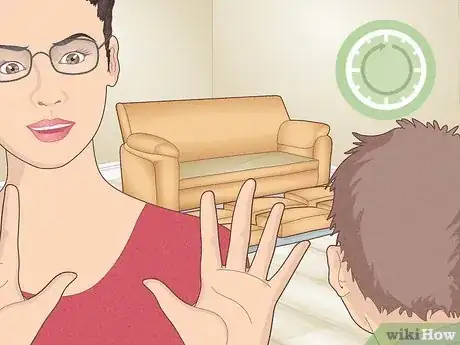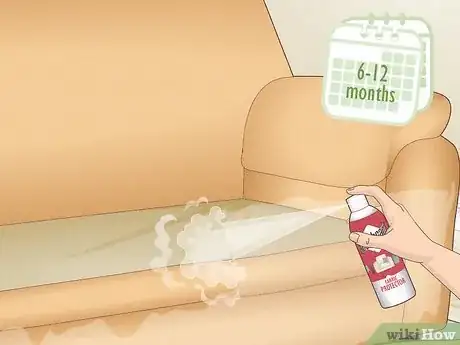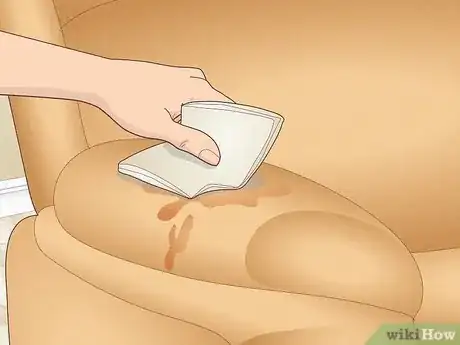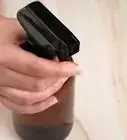This article was co-authored by wikiHow staff writer, Glenn Carreau. Glenn Carreau is a wikiHow Staff Writer, currently based in Los Angeles. With over four years of experience writing for several online publications, she has covered topics ranging from world history to the entertainment industry. Glenn graduated with honors from Columbia College Chicago, earning a B.A. in Interactive Arts and Media and a minor in Professional Writing. Today, Glenn continues to feed her lifelong love of learning while serving wikiHow's many readers.
This article has been viewed 5,225 times.
Learn more...
Did you know that applying Scotchgard to your own furniture at home isn’t nearly as messy as you might think? Scotchgard is a simple spray treatment that prevents spills from soaking into your couch (or chairs and other upholstery) without making the fabric feel stiff and crunchy. Read on for a complete guide to Scotchgarding your sofa and protecting it from pets, kids, spills, and stains.
Things You Should Know
- Clean the couch with water or dry cleaner detergent before treating it with Scotchgard to ensure that it looks fresh and neat long-term.
- Prepare by opening the windows and moving the couch away from the wall. Lay a drop cloth underneath the couch and wrap the legs in masking tape.
- Shake the can of Scotchgard and do a spot test first. Then, coat the entire couch twice, waiting 2 to 4 hours between coats, and let the couch fully dry.
Steps
Steam-clean or wash your couch.
-
Clean the couch before adding Scotchgard to preserve its tidy appearance. If you’re working with an older couch, you don’t want to preserve any existing stains or dirt particles. Scotchgard is designed to work with washable fabrics like cotton, polyester, silk, wool, acrylic, and nylon. Check your couch for a tag with a coded letter that’ll tell you what kind of fabric it's made of. Then, clean the couch according to the tag’s instructions.[1] X Research source If the couch is already clean (or new), lightly vacuum it to remove dust instead.
- W: Wash away dirty spots on the couch with a water-based upholstery cleaner, or use a steam cleaner to remove dirt and stains if necessary.
- S: Spot-clean the couch with dry cleaning solvent to get rid of stains and dirt. This fabric isn’t meant to be washed with water.
- WS: Use either a water-based upholstery cleaner or a dry cleaning solvent to spot-clean stains. Both water and solvents are safe for use on this fabric.
- Scotchgard isn’t intended to be used on leather or suede. If your couch’s fabric code is “X,” that means it can’t be cleaned with water or solvents, and won’t work with the Scotchgard either.
Open windows in the room.
-
Ventilate the area to ensure you don’t breathe in too many fumes. Take a moment to open every window in whichever room you plan to Scotchgard your couch wide enough for plenty of air to get in (and out). Leave the windows open for the duration of your project so the Scotchgard fumes don’t linger inside the house.[2] X Research source
- If you have the means, you could also spray your couch outside or in the garage where there’s natural ventilation.
- Keep any children and pets away from your workspace while you Scotchgard the couch as well.
Lay a drop cloth over the floor.
-
A drop cloth protects your floor from getting stained by the Scotchgard. Spread a drop cloth across an clutter-free area where you plan to spray down your couch. Ensure the cloth is wide enough to cover some extra floor space around the couch, too. Scotchgard is intended to work with fabrics—not hard surfaces like your floor.[3] X Research source
Push your sofa away from the wall.
-
Ensure no Scotchgard touches the wall as you apply it. Since you don’t want any Scotchgard spraying the wall and leaving marks, move your couch at least 3 feet (0.91 m) away from all the walls in the room to be safe. Leave enough room to spray down your couch without any Scotchgard reaching the wall.[4] X Research source
- Pick the couch up just enough to slide the drop cloth underneath it. When you’re done, the legs of the couch should be resting on top of the cloth.
- It’s important to ensure the couch is well away from every wall so you can safely spray from several different angles. Consider every angle you’ll need to spray from as you position the couch!
Move nearby furniture out of the way.
-
Protect surrounding items from the Scotchgard by clearing the area. If there’s anything else near your couch—like tables, lamps, or even toys on the floor—clear them away from the couch so that the drop cloth can stretch out to its full length and width. When you’re done, there shouldn’t be anything in the path of the Scotchgard, regardless of the angle you spray from.[5] X Research source
- If there is any accidental overspray onto other pieces of furniture while you’re applying the Scotchgard, just wipe it up quickly. Scotchgard can cause white discolored stains when it gets on the wrong furniture.
Cover the couch legs with tape and remove its cushions.
-
Masking tape protects the couch’s legs from accidental spray stains. Just like floors, the legs of the couch aren’t meant to be sprayed with Scotchgard. Wrap masking tape around the legs of the couch until each leg is fully covered. Then, remove the couch cushions and lay masking paper across the bare seat of the couch.[6] X Research source
- Place the couch cushions on the drop cloth’s remaining space, or prepare a separate drop cloth for them. Either way, the easiest way to ensure total coverage is to spray the couch and cushions separately.
Shake the can of Scotchgard.
-
Mix up the contents of the can by shaking it for about 10 seconds. A newly purchased bottle of Scotchgard probably isn’t mixed very well, because sitting on a shelf without moving makes the bottle’s contents settle. Shake the bottle up and down to ensure the spray is well-mixed before you apply it.[7] X Research source
- Scotchgard will spray if you don’t shake the bottle first, but it won’t coat your couch as effectively as a shaken bottle.
Do a spot test on the couch.
-
A quick test can show you whether the fabric is colorfast. Since Scotchgard can ruin some fabric's color, ensure your couch won't be damaged by the spray before coating it. Find an inconspicuous patch of fabric that isn’t visible normally and spray it with Scotchgard. Then, rub the patch of fabric with an absorbent, lint-free white cloth. If the cloth comes away white, you can use the Scotchgard.[8] X Research source
- If any color rubs away onto the white cloth, then the Scotchgard won’t work with your couch.
Spray the couch with Scotchgard.
-
Hold the can upright, 6 in (15 cm) away from the couch's surface. Start at one of the couch’s top corners and apply the Scotchgard in long, sweeping lines from right to left that each overlap slightly. Do the same for the cushions you removed, coating all sides. Once you’ve covered the couch, wait for 2 to 4 hours for the spray set into the fabric and dry completely.[9] X Research source
- This coat should be thorough, but it doesn’t have to be heavy. Scotchgard is more effective in 2 lighter coats than 1 thick coat.
- Keep in mind that the humidity where you live can affect drying times. If you live somewhere dry, it’ll take about to 2 hours—but if it’s humid outside, it might take closer to 4 hours.
Apply a second coat of Scotchgard.
-
Multiple coats will protect your couch more effectively. Cover the couch and cushions with Scotchgard the same way you did the first time around, ensuring that every surface gets a second coat of spray. Keep this coat light, too; a heavier spray application takes longer to dry, and there likely won’t be enough spray in the bottle to do a heavy second coat.[10] X Research source
- Scotchgard bottles typically contain enough spray to cover a single couch (counting both coats).
- By the end of the application, your couch should be lightly damp but not wet.
Keep everyone off the couch for 24 hours.
-
Using the couch before it’s dry can disrupt the Scotchgard’s effectiveness. Leave the couch and cushions alone overnight to ensure that the Scotchgard dries completely and sets into the fabric as intended. The next day, set up your couch and move it back into place (along with any other furniture you moved).[11] X Research source
- With that, your couch is waterproofed and ready for use!
Re-apply the Scotchgard every 6 to 12 months.
-
Re-applications keep the fabric protected long-term. Scotchgard wears off over time, so remind yourself to give your couch a new coating of spray every year, depending on how well-used it is. For example, if the couch gets used all the time, try to re-spray it every 6 months. If it’s rarely used, then it’s safe to wait and give it yearly re-applications of Scotchgard.[12] X Research source
- Consider cleaning the sofa before each re-application, too, so it always looks neat and brand new!
Spot-clean stains on a Scotchgarded couch.
-
Blot the area before applying a cleaner according to the fabric tag. Absorb the stain with a plain paper towel, applying pressure until it no longer soaks into the paper. Then, using a water-based upholstery cleaner or dry solvent (once again depending on your couch’s fabric tag), dab a little cleaner onto the stain and blot it with a clean rag until the stain fades away![13] X Research source
- Once you’re done, rinse away the cleaner by dampening a cloth or paper towel with water and blotting the area to soak up any remaining solvent.
You Might Also Like

 How to Get Spray Foam off Your Hands
How to Get Spray Foam off Your Hands






 How to Defrost a Samsung Ice Maker: A Quick Guide
How to Defrost a Samsung Ice Maker: A Quick Guide



References
- ↑ https://www.apartmenttherapy.com/how-to-read-upholstery-cleanin-57653
- ↑ https://trendycouches.com/how-to-scotchgard-a-couch-personally-at-home/
- ↑ https://trendycouches.com/how-to-scotchgard-a-couch-personally-at-home/
- ↑ https://krostrade.com/blog/how-to-scotchgard-a-sofa/
- ↑ https://www.scotchgard.com/3M/en_US/scotchgard/how-to-fabric-upholstery-protector/
- ↑ https://trendycouches.com/how-to-scotchgard-a-couch-personally-at-home/
- ↑ https://www.scotchgard.com/3M/en_US/scotchgard/how-to-fabric-upholstery-protector/
- ↑ https://trendycouches.com/how-to-scotchgard-a-couch-personally-at-home/
- ↑ https://homesteady.com/12450485/how-to-scotchgard-a-sofa
About This Article

